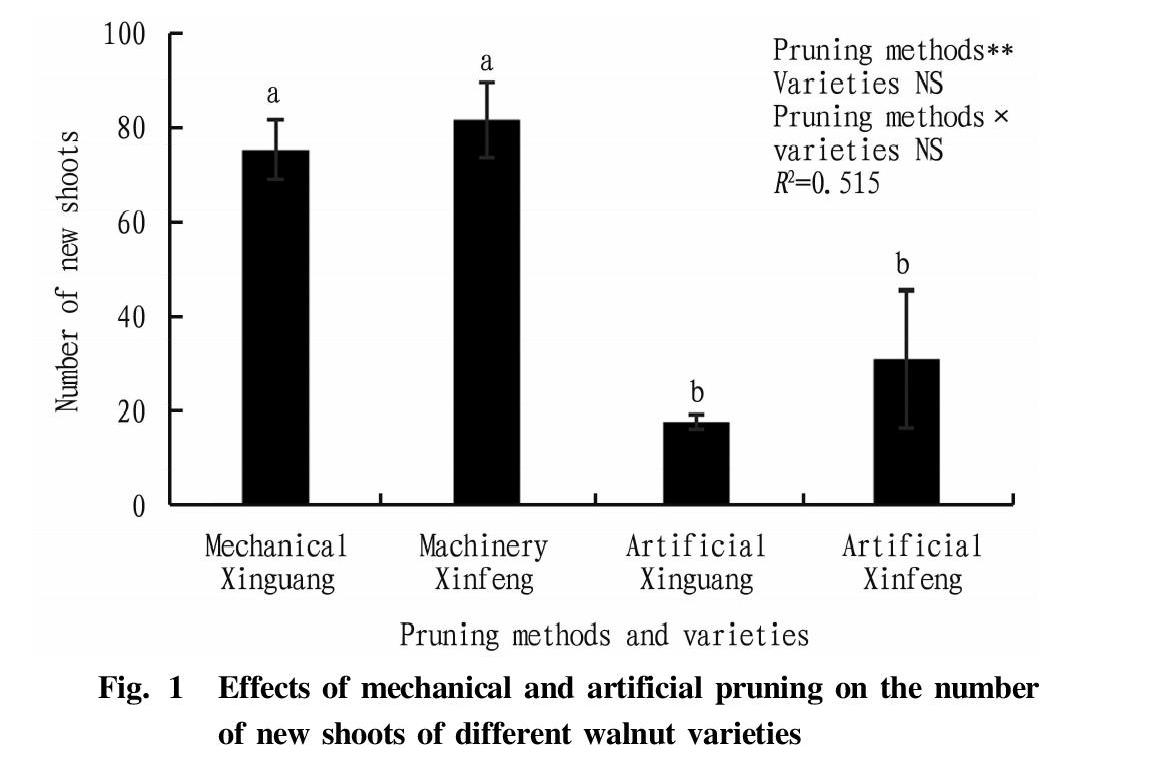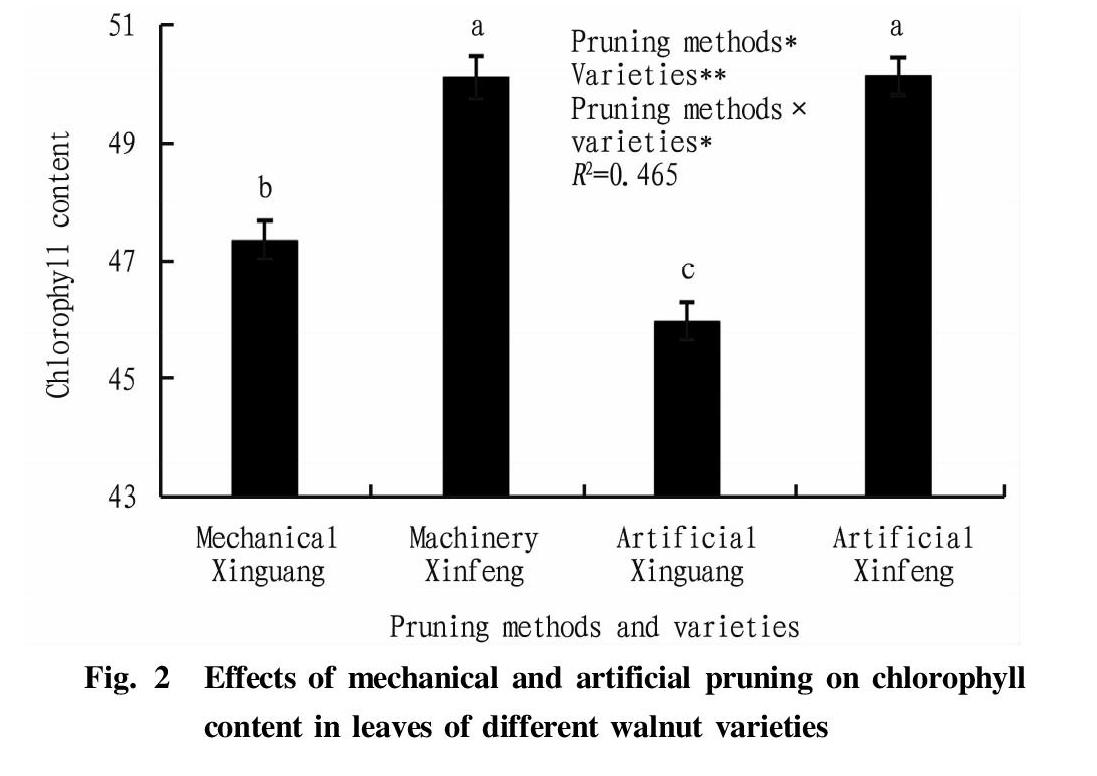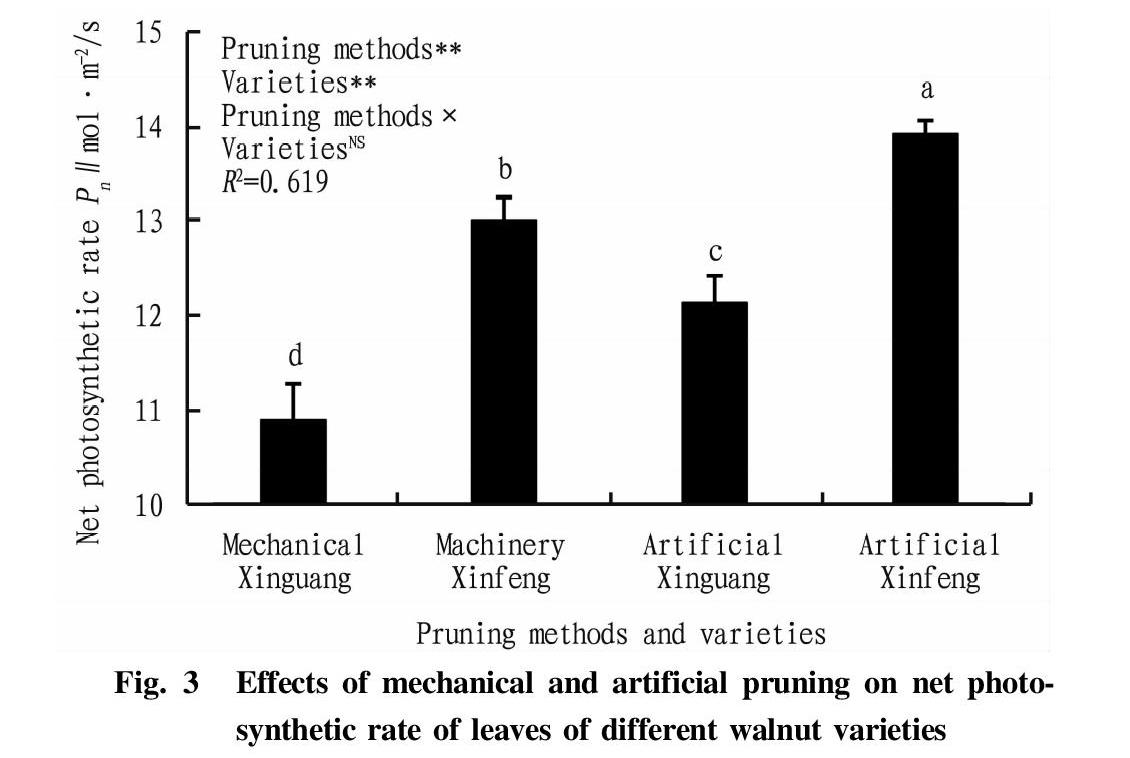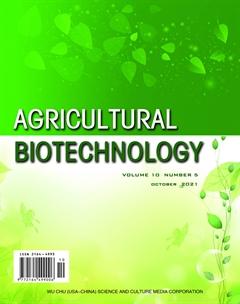Effects of Pruning Methods on the Growth and Development of New Shoots and Fruit Yield and Quality of Walnut
ABDUXUKUR Yakup MUHTAR Zari MANSUR Nasir



Abstract [Objectives] This study was conducted to screen out reasonable pruning methods of walnut, and provide practical guidance for high-yield cultivation of walnut.
[Methods]Xinfeng and Xinguang were used to study the effects of mechanical and artificial pruning methods on shoot growth, chlorophyll content in leaves, net photosynthetic rate and fruit quality.
[Results] The results showed that: ① the pruning method had a significant impact on the number of new shoots, and the number of new shoots of mechanical pruning was significantly higher than that of manual pruning; ② the pruning method had a significant impact on the chlorophyll content, and the chlorophyll content of Xinguang of mechanical pruning was significantly higher than that of manual pruning; ③ the pruning method had a significant impact on the net photosynthetic rate of leaves, and the net photosynthetic rate of manual pruning was significantly higher than that of manual pruning; ④ Pruning methods had a significant effect on the number of walnut fruit, and the fruit trees pruned manually were significantly higher than those pruned mechanically; ⑤ the pruning method had no significant impact on the single fruit weight; ⑥ Pruning methods had a significant effect on the shell yield of a single walnut plant. The shell yield of single walnut plant pruned manually was significantly higher than that pruned mechanically; ⑦ pruning mode had a significant impact on the yield of walnut per plant, and the yield of artificially pruned walnut per plant was significantly higher than that of mechanical pruning; and ⑧ Xinfeng餾 chlorophyll content, net photosynthetic rate, fruit number, shell yield per plant and kernel yield per plant were all better than that of Xinguang, in addition, the growth and development of new shoots, the fruit quantity and quality of fruit also were affected by the interaction effect of genotype and pruning mode×variety.
[Conclusions]It can be seen that different pruning methods have significant effects on the growth and development of new shoots and fruit yield and quality of walnut. Artificial pruning is more suitable for walnut cultivation by adjusting photosynthesis and improving the yield and quality of walnut; and Xinfeng is more suitable for popularization and production.
Key words Walnut; Pruning method; Manual pruning; Mechanical pruning
Received: June 30, 2021 Accepted: September 1, 2021
Supported by the Project of Demonstration of Walnut Fine Variety Promotion and Standardized Management Technology in the Technology Promotion Demonstration Project of Central Finance Forest and Grass Science in 2020[Xin [2020] No.TG12].
ABDUXUKUR Yakup (1981-), male, P. R. China, devoted to research about breeding of walnut varieties, physiology of seed and fruit tree cultivation.
*Corresponding author.
Walnut (Juglans regia L.) is one of the main fruit tree species in Xinjiang. It has a long history of cultivation. Under the influence of nature and man-made, it breeds rich variety resources, which provides favorable conditions for the selection of excellent walnut varieties. In recent years, with the development of characteristic forest and fruit industry in Xinjiang, the planting area of walnut has expanded rapidly. From the 1970s to the 1990s, Xinjiang scientists and technicians have bred 22 excellent walnut varieties and 4 strains for more than 20 years[1], among which many are early fruiting varieties with early fruiting characteristics, including J. regia "Xinfeng", J. regia "xinwen179", J. regia "zha343", J. regia "Xinguang", J. regia "Xinguang" "Xinzaofeng" and other early bearing varieties have become the main varieties popularized in Xinjiang walnut production area, which plays an important role in the sustainable development of Xinjiang walnut industry. Photosynthesis plays an important role in the growth and development of fruit trees, which affects flower bud differentiation and fruit quality. Chlorophyll is the main pigment of light energy absorption and transmission in photosynthesis of higher plants, and its content is one of the important indexes reflecting the photosynthetic capacity of plants[2]. At least 90% of the substances in the plant are from photosynthesis. Pruning is the key link to adjust the structure of the tree and the light conditions of the crown. Proper pruning can improve the chlorophyll content and photosynthesis efficiency of fruit trees[3-5], so as to achieve the goal of early bearing, multiple bearing and successive high yield. Pruning methods mainly include manual pruning, mechanical pruning and automatic pruning. Different pruning methods are selected according to the scale of orchard, planting mode, labor force and other factors. At present, there are some problems in the cultivation and management of Xinjiang walnut, such as artificial pruning, high labor cost, low intelligent level of mechanical pruning, and failure to achieve reasonable pruning effect. In recent years, the research on early bearing walnut mainly focused on photosynthetic characteristics[6-7], reproductive characteristics[8], nutrient metabolism[9], stress resistance[10-11] and chlorophyll fluorescence characteristics[12], and the research on shoot growth, light cooperative use and fruit yield under specific environmental background has not been reported. In this study, Xinfeng and Xinguang were used as research materials to study the effects of mechanical and artificial pruning methods on the growth of new shoots, chlorophyll content of leaves, net photosynthetic rate and fruit quality, so as to find out reasonable pruning methods for walnut and provide theoretical basis for high-yield cultivation of walnut.
Materials and Methods
The experiment was set up in Saibage Township, Walnut Town, Yecheng County, Kashi Prefecture, Xinjiang Uygur Autonomous Region. The annual average temperature of the township was 11.3 ℃ (-22.7℃-39.5℃) and the accumulated temperature reached 4 042 ℃. The experimental site was rich in sunshine and heat, with annual sunshine hours (≥10 ℃) of 272 h. The first frost day was October 17, the last frost day was February 9, and the frost free period was 228 d. The permafrost period started in the first ten days of November and ended in the middle of March of the next year, with a depth of 25 cm. The annual average precipitation was 54 mm, the annual evaporation was 2 480 mm, and the temperature difference between day and night was 6-10 ℃.
Materials
In this experiment, Xinfeng (formerly named Heshang No.10) and Xinguang, two walnut varieties with 7-year-old (8-year-old rootstock) in full fruit stage, were used as experimental materials. The experiment was set in the orchard of group 5, village 12, sayibage Township, Yecheng county. The orchard was managed by conventional cultivation method, with a row spacing of 3 m×4 m and a north-south direction, and the tree momentum was basically the same. The photosynthetic effective radiation was over 1 700 mol/(m2·s).
Methods
Determination of chlorophyll content
After measuring the characteristic parameters of chlorophyll fluorescence, the chlorophyll content (SPAD value) of a leaf was measured by a chlorophyll meter (SPAD-502, Konica Minolta sensing Inc., Japan). The chlorophyll content of a leaf was averaged by the measured value of 6 points (3 points on both sides of the midvein of the leaf), and 20 leaves (n=20) were measured for each treatment.
Determination of net photosynthetic rate
From 07:00 to 10:00 on July 11, 2011, the leaf net photosynthetic rates (PN) of the two walnut varieties were measured by standard 2 cm×3 cm of Li-6400 r portable photosynthetic system (Li-6400; li-cor, Lincoln, nebr.).
Determination of yield
Production test method: On July 1, 2011, 10 healthy walnut trees at the same age were randomly tested in each variety of the test site. The number of fruit per plant was investigated and 10 kg of walnut (no green skin) was collected in the orchard on September 15 at the local specified picking period. After walnut was fully dried, the average single fruit weight and average kernel yield were calculated. Finally, the shell yield per plant and kernel yield per plant were converted according to the following formula.
(1) Yield per plant with shell (kg/plant)=Number of results per plant×Average fruit weight per plant with shell (g/plant)/1 000 g
(2) Kernel yield per plant (kg/plant)=Shell yield per plant×Average kernel yield per plant (%)/1 000 g
Statistical methods
T-test was carried out at the P=0.05 (symbol *) and 0.01 (symbol * *) levels, respectively. Ns indicated that there was no significant difference at the P≤0.05 level. The data shown in the chart were mean±standard deviation. All experimental data were analyzed with SPSS 16.0 for windows (copyright SPSS Inc. 2007) and plotted with Microsoft Excel 2013 (Microsoft, Inc.).
Results and Analysis
Effect of different pruning methods on the growth and development of walnut
According to the results of multivariate analysis of variance, pruning method had a very significant impact on the number of new shoots, and the interaction of variety and pruning method×variety had no significant impact on the number of new shoots. According to the results of multiple comparison of variance analysis, the number of new shoots of mechanical pruning was significantly higher than that of manual pruning, but the difference between different varieties of the same pruning method was not significant (Fig. 1).
The results of multivariate analysis of variance showed that variety, pruning method and pruning method×variety interaction had a significant impact on chlorophyll content, among which variety had a significant impact on chlorophyll content. Multiple comparison results showed that the chlorophyll contents of Xinfeng pruned by the two methods were significantly higher than those of Xinguang, while the chlorophyll content of mechanical pruned Xinguang was significantly higher than Xinguang餾. The amount of pruning was significantly higher than that of artificial pruning, and there was no significant difference between different pruning methods of Xinfeng (Fig. 2).
The results of multivariate analysis of variance showed that the pruning methods and varieties had a significant impact on the net photosynthetic rate of leaves, while the pruning methods×varieties interaction had no significant impact on the net photosynthetic rate of leaves. The multiple comparison results showed that the net photosynthetic rates of the two varieties of artificial pruning were significantly higher than those of the corresponding varieties of mechanical pruning. In the same pruning mode, the net photosynthetic rate of Xinfeng was significantly higher than that of Xinguang (Fig. 3).
ABDUXUKUR Yakup et al. Effects of Pruning Methods on the Growth and Development of New Shoots and Fruit Yield and Quality of Walnut
Effect of different pruning methods on yield and quality of walnut fruit
The results of multivariate analysis of variance showed that pruning method, variety and pruning method×variety interaction had a significant impact on the number of walnut fruits. Multiple comparison results show that the fruit bearing trees of the two varieties of manual pruning are significantly higher than those of mechanical pruning, among which the fruit bearing trees of Xinfeng are significantly higher than those of Xinguang, and there is no significant difference between the two varieties of mechanical pruning fruit trees (Fig. 4).
The results of multivariate analysis of variance showed that the pruning method and pruning method×variety interaction had no significant impact on the single fruit weight, and the variety had a very significant impact on the single fruit weight. The multiple comparison results of variance analysis showed that the single fruit weight of the two pruning methods of Xinguang was significantly greater than that of Xinfeng, and there was no significant difference between different pruning methods of the same variety (Fig. 5).
The results of multivariate analysis of variance showed that the pruning method, variety and pruning method×Variety interaction had a significant effect on walnut shell yield per plant; The multiple comparison results show that the shell yield per plant of the two varieties of walnut trimmed manually is significantly higher than that of mechanical pruning, and the shell yield per plant of Xinfeng trimmed manually is the highest, which is significantly higher than that of Xinguang trimmed manually and two varieties of walnut trimmed mechanically. There is no significant difference between the shell yield per plant of the two varieties trimmed mechanically (Fig. 6).
The results of multivariate analysis of variance showed that the pruning method, variety and pruning method×Variety interaction had a significant effect on walnut kernel yield per plant; Multiple comparison results show that the yield of walnut kernel per plant by manual pruning is significantly higher than that by mechanical pruning, among which the yield of walnut kernel per plant of Xinfeng trimmed manually is the highest, which is significantly higher than that of Xinguang trimmed manually, and two varieties of walnut trimmed mechanically. There is no significant difference between the shell yield per plant of the two varieties trimmed mechanically (Fig. 7).
Discussion and Conclusions
Pruning is the key link to adjust the tree structure and crown light conditions. Properly pruned walnut varieties that can give full play to the advantages of light and heat resources in Xinjiang are the key problems to be solved in the development of large-scale walnut[13]. Therefore, finding high light efficiency pruning measures is one of the main problems for early bearing walnuts such as adult Xinfeng and Xinguang. The results showed that pruning methods had significant effects on shoot number, chlorophyll content, leaf net photosynthetic rate, fruit number, fruit weight per fruit, shell yield per plant and kernel yield per plant. Among them, the number of shoots and chlorophyll content of mechanical pruning were significantly higher than those of manual pruning, but the net photosynthetic rate, fruit number, fruit weight per fruit and shell yield per plant of manual pruning were significantly higher. The shell yield and kernel yield per plant were significantly higher than that of mechanical pruning. It shows that mechanical pruning has high efficiency and low cost for collective farmers such as cooperatives. However, because mechanical pruning does not reach the level of intelligent pruning, its pruning method is mainly plastic pruning. As a result, both branches and vegetative branches have been cut off or left behind, which cannot achieve the effect of adjusting nutrition growth and increasing production and value. Although the cost of artificial pruning is high for collective farmers, it can adjust the relationship between vegetative growth and reproductive growth, improve light conditions, improve photosynthesis, and increase production and value. It can be seen that different pruning methods have obvious effects on the growth and development of new shoots and fruit yield and quality of walnut. Among them, artificial pruning method is more suitable for walnut cultivation by controlling the number of new shoots and adjusting photosynthesis to improve the yield and quality of walnut. Xinfeng餾 chlorophyll content, net photosynthetic rate, fruit number, shell yield per plant and kernel yield per plant are all better than Xinguang餾. It can be seen that Xinfeng is more suitable for production and use in this special environment. In addition, variety genotype and pruning method×variety interaction effect also affect the growth and development of new shoots and fruit yield and quality of walnut, which indicates that variety genotype must be considered when choosing the most suitable pruning method.
References
[1] ZHENG YF. Fine variety of Xinjiang walnut (3)[J]. Xinjiang forestry, 1997(5): 19-20.
[2] BULER Z, MIKA A. The influence of canopy architecture on light interception and distribution in ‘Sampion apple trees[J]. Journal of Gerontological Nursing, 2009, 31(3): 25-33.
[3] WANG KL, YAO XH, SHEN W, et al. Effect of pruning and fertilization on chlorophyll content and photosynthetic rate of Camellia oleifera[[J]. Journal of Shandong Agricultural University: Natural Science Edition, 2015(5): 666-670.
[4] LUO LY, YANG DH. Effect of simplified pruning on chlorophyll content, yield and quality of Satsuma[J]. Southern agriculture, 2012, 06(3): 25-26.
[5] JIA ML. Pruning Experiment of weak apple trees in different degrees in winter[J]. Fruit trees in the north, 2005(5): 11-12.
[6] HE Q, WANG G, CHANG YM, et al. Preliminary study on photosynthetic characteristics of early bearing walnut[J]. Journal of Shanxi Agricultural University, 2010, 30(3): 197-200.
[7] YAO Y, PAN CD, HU AH. Photosynthetic characteristics of main early bearing walnut varieties in Xinjiang[J]. agricultural science of Xinjiang, 2011, 48(6): 981-987.
[8] ZHANG ZY, LI BG, ZHANG WL. Reproductive characteristics of different early bearing walnut varieties[J]. Anhui Agricultural Science, 2009, 37(8): 3480-3481, 3505.
[9] WU J, SUN XN, HAO YP. Metabolic rule study on main nutrient elements of precocious walnut leaf[J]. Shanxi Forestry Science and Technology, 2013, 42(1): 45-47.
[10] LIU DL, ZHANG BY, PENG SB, et al. Cold resistance division of leaf tissue structure of different varieties of Jishi early bearing walnut[J]. Journal of fruit trees, 2012, 29(2): 205-211.
[11] XI C, FENG B, PAN Y, ZHANG T, et al. Effect of different cultivation measures on cold resistance of 185 annual walnut branches[J]. Xinjiang Agricultural Science, 2012, 49(11): 1997-2007.
[12] BAI J, PAN CD, HU AH, et al. Comparison of chlorophyll fluorescence characteristics of six walnut varieties in Xinjiang[J]. Journal of Northwest Forestry University, 2010, 25(6): 13-18.
[13] LI MM, MA HB, REN JJ, et al. Effects of pruning methods on physiological characteristics of walnut[J]. Journal of Northwest Forestry University, 2015, 30(1): 108-115.
Editor: Yingzhi GUANG Proofreader: Xinxiu ZHU
- 农业生物技术(英文版)的其它文章
- Selection of Grape Varieties Suitable for Double Cropping a Year in Northern Greenhouse
- Effects of Uniconazole on Photosynthetic Characteristics of Dahlia pinnata Cav. under Drought Stress
- Community Structure and Value Evaluation of Local Brassicaceae Potherbs in Shiyan City
- Home Planting Techniques of Green and Healthy Rape Sprouts
- Research Progress of Polygonatum Germplasm Resources in China
- Breeding and Application of Guidan 903, a New High-yield and Good-quality Maize Variety

